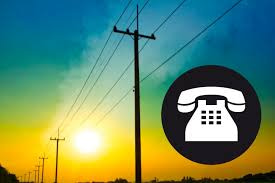In June (2024) the California Public Utilities Commission rejected AT&T’s bid to stop offering landline telephone service. Older people may be cheering this decision, but it’s hard to believe that the landline will continue to stay the same.
Still, there can be holdovers when it comes to beloved technologies. The QUERTY keyboard continues to be used even when there are more efficient ways of entering letters and numbers. In automotives we talk about horsepower because the term evolved from how much energy a horse expended. And in telecommunications, first responders still use paging devices because occasionally they are faster and more dependable. But change is afoot.
Today, only about 25% of adults in the US still have landlines and only around 5 percent say they mostly rely on them. The largest group of users, of course, are 65 and older. The technology for landline service is old and simple: copper lines in the wall and on poles carry their own electricity. This is key, because they do not have to depend on an outside source for power. So, in principle, they continue to work during a power outage.
However, the reliability of the landline is no longer a certainty because of changes in how calls are routed. For an example of what happened to landline service during the 2019 fires in Northern Calfiornia, read here.
Why Keep a Landline?
So, why do people keep their landlines? There are a couple of reasons. In rural areas, and California has many of those, everyday cell service can still be spotty. However, recent satellite services or those trusty pagers can provide a fix.
Second, some people, particularly seniors, know landlines to be familiar and accessible. They worry that in the face of a disaster they would panic, and forget how to use their mobile devices. Or, they might have left the device uncharged. And, despite the large number of robocalls that landlines receive today, people may perceive that a landline provides greater privacy and security,
But, for older people, it is the security that they can reach 911 and keep safe during natural disasters. But there are two ironies here. First, 100% reliability is no longer guaranteed, because routing calls with fiber optics requires an outside source of electrical power. Second, those hoping to avert a natural disaster may miss the text warnings and updates that are more readily available through mobile phone networks.
There is a closely related misperception that cordless phones which plug into the wall, typically called Voice Over Internet Protocol (VoIP), will work like a landline during an emergency. The similarity to a landline ends at the wall, because these phones depend on having both electricity or a backup battery, and a WiFi connection. They resemble cell phones more than a landline.
COLR
The decision by the California Public Utilities commission to keep the landline was not solely driven by emergency communications. In parts of the state, AT&T is designed as a Carrier of Last Resort (COLR) for underserved populations. To support this obligation, AT&T receives “Lifeline” funding which all telcom users pay for. Ironically, the very poorest families are more likely to have cell phones than landlines, probably because it’s cheaper for them and they are less likely to have a permanent address.
Still, the landline is not likely to go away as long as older people continue to lobby for it, and until some other means is found to fulfill COLR needs. COLR rules are technology-neutral, meaning that if AT&T phases out the copper cables, but invests in other technology, say more fiber optics with battery backup, they may find a way to transmit old voices in new containers.

